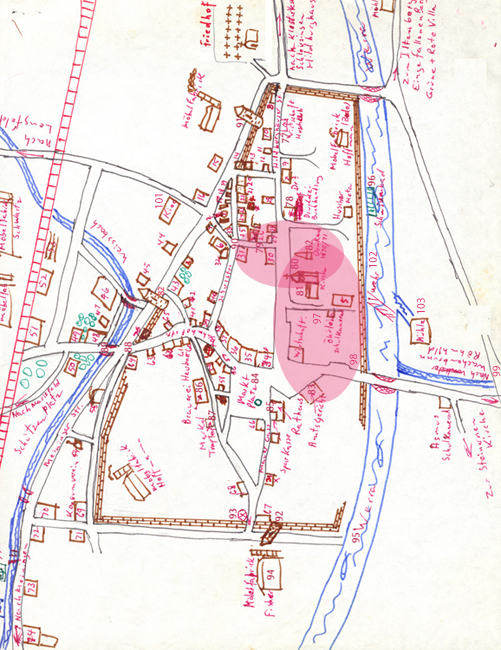You are here! Here we move further west along Hildburghäuser Strasse,
starting more or less in front of the Denkmal/War Memorial (#82) and ending in Shoe Market/Schumarkt (#84).

This corner and around it you are going to see quite a bit of now. The 4th house on the right belonged to a Mr. Haass. He had a machine shop (“Schlosserei”). His wife was a Kahn daughter and they had twin daughters. I don’t know what happened to them, maybe they survived as half-Jews. My violin teacher lived in the back annex of this house. The Nazis told him to quit teaching me. This picture was taken in 1983, in the earlier pictures there are small differences.
[Editor’s Note: In 1924, Hermann Wilhelm Haass, a Christian, b. 1896 in Themar, married Erna Kahn, b. 1897 Themar, daughter of Josef Kahn and Hulda Walther Kahn. Wilhelm and Erna had twins in 1928, a boy, Günter, and a girl, Johanna. Wilhelm and Erna both died before WWII; both Günter and Johanna survived the war.]

This picture was taken in 1976, looking northeast along Georgstrasse (#79) towards the new school. Notice the name “Schmidt Installation” on the house on the left (#30). It is not there anymore in 1983. The house on the right (#29) was a barber shop where I got my haircuts. The War Memorial (site #82) is for the German-French War of 1870-71.

Looking down the street from the other end [Schulstrasse]. The house on the left (#26) was our Co-op store, the “Konsumverein, Themar GMBH.” In the back was a bakery. My grandpa [Abraham Schwab] went there every morning to get his fresh and slightly burned buns, Semmeln, for breakfast.

The same corner 1922 or 1923, Pfingstzug/Pentecost or maybe Maifest/May Festival, early 1920’s. Notice the name Schmidt (#30), it took a long time to get rid of that. On the right side of both pictures are the numbers 1 and 2 written above two people. Number 1 is [my father] Paul Rosengarten and number 2 is a friend of my father’s by the name of Lothar Frankenberg. He was the Shofar Blower in the Synagogue. He was the uncle of Norbert and Marion Sander, more about them later. Lothar fathered an illegitimate daughter with the forester’s daughter, quite a scandal at the time. I went to school with her, her stepdad was a top Nazi, “der krummbeinige Kranz” or “bowlegged Kranz.”
[Editor’s note: Lothar Frankenberg left Germany in 1939 for North America; he lived in Montreal, Canada where he married. He died in 1975. Marion Sander left Germany for the United States in May 1939. Norbert Sander, who was epileptic, was unable to leave Germany and was murdered in the Euthanasia program in 1941.]


Somebody lived all the way on the top. He was the bell-ringer and clock regulator. He also carried the crucifix in funeral processions. There was no elevator and they had to carry their water up all those stairs. Christmas and New Year’s Day, the City brass band played carols from the top, taking turns at the large openings. So all four sides of the town got a treat. A friend of my father’s played the trombone, he also ran the hydro-electric plant.


The fancy house is the Pfarrhaus/Pastor’s House. He was a good man, he denounced the Nazis from the pulpit after the boycott of April 1st, 1933. After that, he disappeared and was never seen again. His replacement was very tall and skinny, and people called him “G-d’s pencil.” Also that he could drink from the gutters on the roof, while kneeling. He wore a swastika armband in the pulpit.
In the house with the slanted beams (#97) lived Fritz Öhrlein [see p. 91], who went to school with me. He was the tallest boy in my class. He hated me because he could not beat me in running, only once did he get lucky, I had twisted my ankle and he challenged me to a re-run and he beat me only by inches. I limped for days.

Ducal Courthouse, I think Duke of Meiningen. The small color pictures were sent to me by Margarete Mittag née Blau, a schoolmate. Her husband is the town photographer, they are re-photographed old picture postcards.

This building is now an ambulatorium or nursing home or something like that. Where the sign is used to be a pump and watering trough for livestock. People got their water from the pump also, I mean hand pump. During a flood, a long timber which had broken loose from a raft on the Werra River came shooting down Hildburghäuser Str. and hit that trough, which was iron, and made quite a noise like a big gong. To the left, where the road curves around the building, there was a little stationary and arts supply store in the last house on the left (#98). It sits on top of the old city wall, which runs along the Werra River there. A bridge is helping the road across, otherwise it would be one hell of a drop.

Chapter 4: Marktplatz/Market Square
Chapters: 1 | 2 | 3 | 4 | 5 | 6 | 7 | 8 | 9 | 10 | 11 | 12 | 13
Material from M. Rosengarten, Themar, Thüringen: My Home Town may be reproduced in part or whole, in any print or electronic format for non-commercial purposes provided that the author, editor, copyright holders, and publisher (www.judeninthemar.org) are acknowledged.
© 2011 Vancouver Holocaust Education Centre. © Sharon Meen, Vancouver, British Columbia
